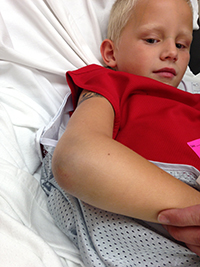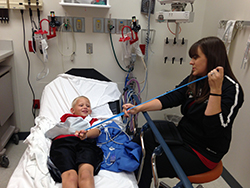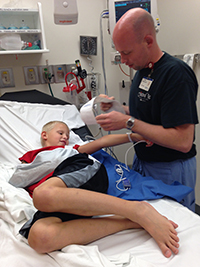 By the time Aiden Stigers wound up in St. Louis Children’s Hospital’s emergency department, he’d already had a pretty exhausting day.
By the time Aiden Stigers wound up in St. Louis Children’s Hospital’s emergency department, he’d already had a pretty exhausting day.
“A bear came through the back door, jumped up on me and I had to kick him away! He left, but I still broke my arm,” the animated 6-year-old said, pointing to his right arm, wrapped in a sling.
His mom, Jill, laughed. Aiden and his parents had driven more than two hours to St. Louis, and had worked on a “good story” along the way. He actually tripped that morning as he was getting ready to leave for school. An x-ray at their local emergency room revealed a broken arm.
“They didn’t have anyone there who could take care of pediatric patients, so they told us to head on up to Children’s, that the ER here would be waiting for us,” Jill recounted.
Aiden would have to have his arm set, which would require IV sedation – a prospect often more frightening for a child than a broken bone.
“Needles make kids nervous. And when they’re nervous, they clamp down. It’s harder for the doctors and nurses, and it makes the procedures more painful,” says Jordan Foy, Child Life Specialist in the emergency department.
In the 1990s, Dr. Bo Kennedy pioneered the concept of an “ouchless” emergency room at St. Louis Children’s Hospital. The phrase would become, in his words, “Not a guarantee, but a philosophy and a goal.”
 Clinicians started using buffered lidocaine to numb skin before needle sticks. They would use the smallest needles available, offer local anesthetic for IV starts or nitrous oxide (laughing gas) for potentially painful procedures. When needed, children would receive pain medicine at triage to make any wait more bearable.
Clinicians started using buffered lidocaine to numb skin before needle sticks. They would use the smallest needles available, offer local anesthetic for IV starts or nitrous oxide (laughing gas) for potentially painful procedures. When needed, children would receive pain medicine at triage to make any wait more bearable.
“Literature suggests painful procedures have long term consequences,” Kennedy explains. “We don’t want experiences these children have now to cause them to fear medical care in the near future, or avoid it in the distant future.”
In addition to offering medical interventions to limit pain, emergency room physicians and nurses have recently begun relying on child life specialists and distraction techniques.
While Aiden’s nurse started his IV, Jordan held an iPad directly in front of the child’s face. He watched a few minutes of his favorite show while Jordan explained everything the nurse was doing.
 “If he doesn’t see the needle, he doesn’t have time to get worked up about how much it might hurt,” Jordan says. “At the same time, we don’t believe in surprises. I’m explaining everything that’s happening as its happening. He knows what’s going on, but he doesn’t have to see it.”
“If he doesn’t see the needle, he doesn’t have time to get worked up about how much it might hurt,” Jordan says. “At the same time, we don’t believe in surprises. I’m explaining everything that’s happening as its happening. He knows what’s going on, but he doesn’t have to see it.”
According to Dr. Kennedy, the iPads have made a world of difference.
“When Child Life has them engaged, I can do virtually whatever I want to do. As long as we can control the pain, the iPad can relieve the anxiety.”
The ouchless methods have proven so successful in the emergency department, they’re now being introduced as needed throughout the hospital. Jordan has watched the transition.
“I see IVs administered both with ouchless techniques and without, and the change is huge. With ouchless, the kids are so much more relaxed, and the procedure is easier. They are able to turn their attention away from the pain and trust that we’re going to do what needs to be done quickly, and with little pain.”
The emergency department staff urges parents to stay with their children during procedures. Aiden’s parents were just a few feet away, and they watched, stunned, as Aiden literally sang through his IV start.
“He’s a tough kid,” his mom, Jill remarked, “but that was amazing.”










